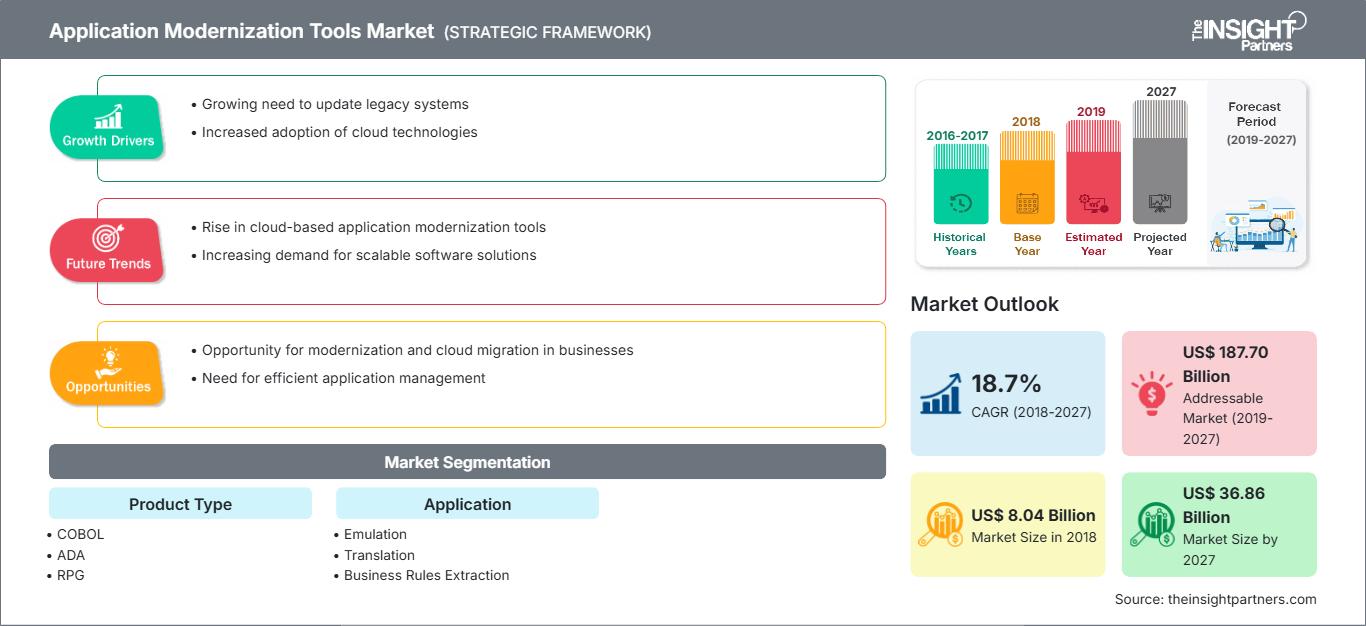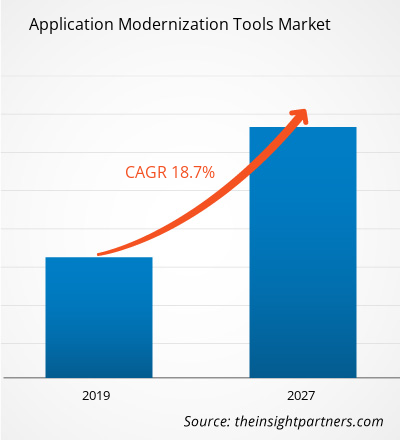Der globale Markt für Tools zur Anwendungsmodernisierung belief sich 2018 auf 8,04 Mrd. USD und soll im Prognosezeitraum 2019–2027 mit einer durchschnittlichen jährlichen Wachstumsrate (CAGR) von 18,7 % wachsen und bis 2027 36,86 Mrd. USD erreichen.
Nordamerika wird bis 2027 voraussichtlich den größten Marktanteil bei Tools zur Anwendungsmodernisierung halten. Die Regierungen maximieren ihre digitalen Investitionen, indem sie neue Technologien sowie Daten und fortschrittliche Analysen strategisch einsetzen, um Richtlinien und Programme zu optimieren und ihre Altsysteme zu aktualisieren. Sie verbessern und richten Prozesse aus, gewinnen neue Investoren, bringen einen intelligenten, datengesteuerten Ansatz in den Regierungsbetrieb, bieten einen besseren Zugang zu Informationen und verbessern deren Verwaltung, erhöhen die Zufriedenheit und das Vertrauen der Bürger und transformieren staatliche Transaktionsdienste. Die Erfüllung der Anforderungen einer sich rasch verändernden demografischen Entwicklung sowie die Kostenbalance bei gleichzeitiger Effizienzoptimierung spielen eine wichtige Rolle bei der laufenden IT-Transformation im staatlichen, öffentlichen und privaten Sektor.
Markteinblicke: Die zunehmende digitale Transformation in allen Branchen treibt die Nachfrage nach Tools zur Anwendungsmodernisierung an.
Durchgängige Geschäftsprozessoptimierung, erhöhte Betriebseffizienz, verbesserte Kundenerfahrung und Kostensenkung sind nur einige der Faktoren, die den Markt für Tools zur Anwendungsmodernisierung antreiben. Der Paradigmenwechsel der Unternehmen von traditionellen hin zu digitalen und automatisierten Kanälen bringt zahlreiche Vorteile mit sich, die von verbesserter Effizienz über Kostensenkungen bis hin zu erhöhten Umsatzchancen reichen und so das Wachstum des Marktes für Tools zur Anwendungsmodernisierung fördern.
Passen Sie diesen Bericht Ihren Anforderungen an
Sie erhalten kostenlos Anpassungen an jedem Bericht, einschließlich Teilen dieses Berichts oder einer Analyse auf Länderebene, eines Excel-Datenpakets sowie tolle Angebote und Rabatte für Start-ups und Universitäten.
Markt für Tools zur Anwendungsmodernisierung: Strategische Einblicke

-
Holen Sie sich die wichtigsten Markttrends aus diesem Bericht.Dieses KOSTENLOSE Beispiel umfasst Datenanalysen, die von Markttrends bis hin zu Schätzungen und Prognosen reichen.
Die Akteure im Markt für Tools zur Anwendungsmodernisierung integrieren verschiedene Lösungen in Anwendungen und Front-Ends auf Tablets, Mobilgeräten und im Internet. Dies ist eine kostengünstige und schnelle Möglichkeit, neue Geschäftsprozesse anwendungsübergreifend bereitzustellen. Dienstleister integrieren Lösungen wie Robotic Process Automation (RPA), eine As-a-Service-Automatisierungsplattform. Sie ermöglicht die Nachbildung der Interaktion zwischen Technologie und Mensch, um eine Vielzahl von Betriebs- und Supportprozessen kostengünstig zu automatisieren und die Zuverlässigkeit zu erhöhen.
Produkttyp-Einblicke
Der globale Markt für Tools zur Anwendungsmodernisierung nach Produkttyp wurde vom COBOL-Segment angeführt. Der Prozess der Anwendungsmodernisierung ist mit herkömmlichen Methoden recht anspruchsvoll, wurde jedoch durch die Einführung agiler Technologien einfacher und präziser. COBOL ist eine höhere Programmiersprache, die vollständig webbasierte Anwendungen generiert und Projekte innerhalb des vorgegebenen Zeitrahmens neu gestaltet. Dabei werden Standards umgesetzt und Spezifikationen für ein besseres Erscheinungsbild befolgt, wobei die Modernisierung in .NET- und Java-Anwendungen erfolgt. Verschiedene auf dem Markt verfügbare Plattformen wandeln vorhandenen Code in fortgeschrittene Sprachen um.
Anwendungseinblicke
Der globale Markt für Tools zur Anwendungsmodernisierung wurde 2018 vom Emulationssegment angeführt. Es wird erwartet, dass dieses Segment bis 2027 den größten Marktanteil an Tools zur Anwendungsmodernisierung halten wird. Emulation ist ein Prozess zur Neuhosting/Neuplattformierung des Modernisierungsansatzes, der verwendet wird, um eine Umgebung bereitzustellen, die auf verteilten Plattformen kompiliert, indem die bestehende Betriebsumgebung emuliert wird. Die Emulationsfunktion reduziert die Menge und die Änderungen, die zum Zeitpunkt der Migration des Altsystems auf eine verteilte Plattform auftreten. Der Emulationsprozess bietet die schnellste Methode zur Migration von Workloads von einem Mainframe und eine vergleichsweise kostengünstige und risikoarme Möglichkeit, die Betriebskosten zu senken und gleichzeitig den Geschäftswert zu erhalten. Diese Faktoren dürften die Nachfrage nach Emulationsanwendungen im Markt für Tools zur Anwendungsmodernisierung ansteigen lassen.
Tools zur Anwendungsmodernisierung
Regionale Einblicke in den Markt für AnwendungsmodernisierungstoolsDie Analysten von The Insight Partners haben die regionalen Trends und Faktoren, die den Markt für Anwendungsmodernisierungstools im Prognosezeitraum beeinflussen, ausführlich erläutert. In diesem Abschnitt werden auch die Marktsegmente und die geografische Lage in Nordamerika, Europa, im asiatisch-pazifischen Raum, im Nahen Osten und Afrika sowie in Süd- und Mittelamerika erörtert.
Umfang des Marktberichts zu Tools zur Anwendungsmodernisierung
| Berichtsattribut | Einzelheiten |
|---|---|
| Marktgröße in 2018 | US$ 8.04 Billion |
| Marktgröße nach 2027 | US$ 36.86 Billion |
| Globale CAGR (2018 - 2027) | 18.7% |
| Historische Daten | 2016-2017 |
| Prognosezeitraum | 2019-2027 |
| Abgedeckte Segmente |
By Produkttyp
|
| Abgedeckte Regionen und Länder |
Nordamerika
|
| Marktführer und wichtige Unternehmensprofile |
|
Dichte der Marktteilnehmer für Tools zur Anwendungsmodernisierung: Verständnis ihrer Auswirkungen auf die Geschäftsdynamik
Der Markt für Tools zur Anwendungsmodernisierung wächst rasant. Dies wird durch die steigende Nachfrage der Endnutzer aufgrund veränderter Verbraucherpräferenzen, technologischer Fortschritte und eines stärkeren Bewusstseins für die Produktvorteile vorangetrieben. Mit der steigenden Nachfrage erweitern Unternehmen ihr Angebot, entwickeln Innovationen, um den Bedürfnissen der Verbraucher gerecht zu werden, und nutzen neue Trends, was das Marktwachstum weiter ankurbelt.

- Holen Sie sich die Markt für Tools zur Anwendungsmodernisierung Übersicht der wichtigsten Akteure
Die Marktteilnehmer auf dem Markt für Tools zur Anwendungsmodernisierung konzentrieren sich hauptsächlich auf Produktverbesserungen durch die Implementierung fortschrittlicher Technologien. Einige der jüngsten Entwicklungen sind unten aufgeführt:
- 2019: Atos kündigte die Verbesserung der Atos Managed OpenShift (AMOS)-Plattform mithilfe neuer integrierter Automatisierungsfunktionen der SyntBots-Automatisierungsplattform an. Diese Aufrüstung ist das Ergebnis der Zusammenarbeit zwischen Atos und Red Hat.
- 2018: Micro Focus kündigte die allgemeine Verfügbarkeit von Visual Enterprise Suite 4.0 und COBOL 4.0 an. Dies ist ein wichtiger Schritt bei der Umsetzung seiner Vision der digitalen Transformation, um Kunden die Aktualisierung zentraler Geschäftsprozesse und Technologien zu erleichtern.
- 2017: Blu Age kündigte seine Partnerschaft mit Advanced an, um Advanced seine bahnbrechende Lösung – COBOL-Migration und Datenmodernisierung – anzubieten. Mit dieser Partnerschaft liefert das Unternehmen seine automatisierte Lösung für die Transformation seiner alten COBOL-Anwendungen in Java und .NET.
Globale Marktsegmentierung für Anwendungsmodernisierungstools
Nach Produkt Typ
- COBOL
- ADA
- RPG
- Assembler
- PowerBuilder
- Andere
Nach Anwendung
- Emulation
- Übersetzung
- Geschäftsregelextraktion
Nach Geographie
-
Norden Amerika
- USA
- Kanada
- Mexiko
-
Europa
- Frankreich
- Deutschland
- Großbritannien
- Russland
- Italien
- Restliches Europa
-
Asien-Pazifik (APAC)
- Australien
- China
- Indien
- Japan
- Südkorea
- Restlicher APAC
-
Naher Osten & Afrika (MEA)
- Saudi-Arabien
- Südafrika
- VAE
- Rest von MEA
-
Südamerika (SAM)
- Brasilien
- Argentinien
- Rest von SAM
Firmenprofile
- Advanced Computer Software Group Limited
- Aspire Systems (India) Pvt. Ltd
- Asysco Software BV
- Atos SE
- Blu Age
- Deloitte Touche Tohmatsu LimitedRevolution Inc. (TSRI)
- Virtusa Corporation
- Historische Analyse (2 Jahre), Basisjahr, Prognose (7 Jahre) mit CAGR
- PEST- und SWOT-Analyse
- Marktgröße Wert/Volumen – Global, Regional, Land
- Branchen- und Wettbewerbslandschaft
- Excel-Datensatz
Aktuelle Berichte
Erfahrungsberichte
Grund zum Kauf
- Fundierte Entscheidungsfindung
- Marktdynamik verstehen
- Wettbewerbsanalyse
- Kundeneinblicke
- Marktprognosen
- Risikominimierung
- Strategische Planung
- Investitionsbegründung
- Identifizierung neuer Märkte
- Verbesserung von Marketingstrategien
- Steigerung der Betriebseffizienz
- Anpassung an regulatorische Trends






















 Kostenlose Probe anfordern für - Markt für Tools zur Anwendungsmodernisierung
Kostenlose Probe anfordern für - Markt für Tools zur Anwendungsmodernisierung